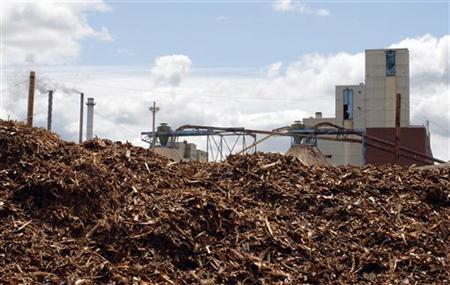Date: 30-Jun-09
Country: GERMANY
Author: Michael Hogan
New Generation Biofuels Seen in 2010 at Earliest Photo: Brian Snyder

Biomass, the unused portions of logged trees such a branches
and the tree tops, sit at the Old Town Fuel and Fiber mill to be burned to
generate electricity in Old Town, Maine.
Photo: Brian Snyder
HAMBURG - The first biofuels produced using new generations of biomass raw
materials could be available in commercial volumes from 2010 at the
earliest, German junior Environment Michael Mueller said on Monday.
But the exact time scale was still unclear, Mueller said at the European
Biomass conference in Hamburg.
Germany is among the first European countries building test plants to
produce commercial volumes of second generation biofuels from a wide range
of biomass materials ranging from wood chips and other forest products to
straw, hay, vegetable waste and low grade crops.
The first generation biofuels made from food crops such as grain, rapeseed
oil and palm oil are used to produce biofuels to reduce use of fossil fuels
and combat global warming. Commercial production dates for second generation
fuels have been repeatedly postponed in Germany as new technology is
developed. A production start as early as 2007 was hoped in the past.
"We do not believe this will take place before 2010," Mueller told a news
conference at the start of the congress. "This was one reason why we cut our
blending levels."
On June 18, Germany's parliament approved government proposals to cut the
compulsory level of biofuels to be blended into fossil fuels this year to
5.25 percent from the 6.25 percent originally intended.
Germany's once-booming biodiesel industry, Europe's largest is working at
about 60 percent of its 4.8 million ton annual capacity and has lobbied for
the blending cut to be stopped.
Germany would focus future rises in its biofuel blending levels on progress
in the production of second generation biofuels from biomass, Mueller said.
COMPLEX PROCESS
Production of new generations of biofuels based on biomass are not likely to
be expanded rapidly as the first generation was introduced in past years,
said Giovanni Federigo De Santi, director of the energy institute at the
European Union Commission's Joint Research Center.
"We want to develop second generation biofuels which move away from
competition from food and (animal) feed," he said. "But because of the
complexity of the production processes we are not so optimistic we will get
second generation biofuels ready in a very short while."
Cost and availability meant first generation biofuels were likely to retain
the main role for some years to come in meeting pollution reduction goals
and combating global warming, he said.
With so much technology still to be developed, Santi said he did not believe
new generation biofuels will be fully deployed for another 10 years.
But low grade biomass could play a large part in heat production to help the
European Union reach its goal of achieving a 20 percent share of renewables
in its final energy consumption by 2020, said Fabrizio Barbaso, the EU
Commission's deputy director general for energy and transport.
Between 10 to 20 percent of the 2020 renewables goal could be met by using
biomass for heat production, Barbaso said.
Second generation biofuels were likely to be used for blending with fossil
fuels rather than for sale individually to special biofuel vehicles, said
Jos Delbeke, the EU Commission's deputy director general for the
environment.
© Thomson Reuters 2009 All rights reserved
